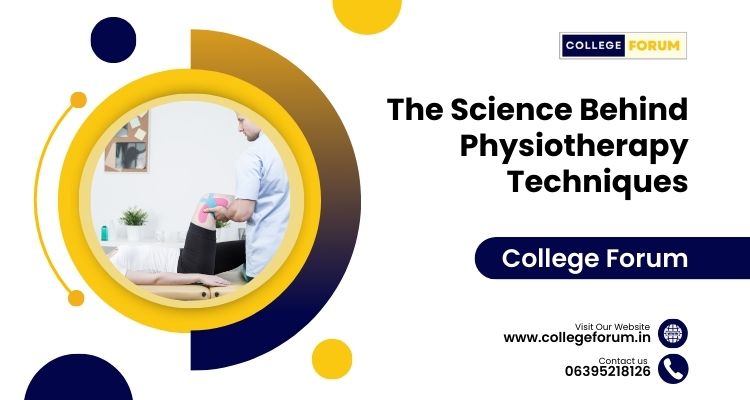Physiotherapy has long been recognized as a vital component in the rehabilitation process for various physical ailments. The science behind physiotherapy is not just about exercises and stretches; it involves a deep understanding of human anatomy, biomechanics, and evidence-based practice to achieve the best outcomes for patients.
Understanding Physiotherapy

Physiotherapy is a healthcare profession focused on the assessment, diagnosis, and treatment of physical dysfunction. It aims to restore, maintain, and maximize physical strength, function, and movement. This practice is supported by scientific research and clinical evidence, ensuring the treatments used are effective and safe.
The Scope of Physiotherapy

Physiotherapy covers a broad range of treatments and interventions. It can be used to treat a variety of conditions, from sports injuries and musculoskeletal disorders to neurological conditions and chronic illnesses. Physiotherapists work in various settings, including hospitals, clinics, sports facilities, and community health centers.
The Role of Evidence-Based Practice in Physiotherapy

Evidence-based practice in physiotherapy involves integrating clinical expertise with the best available research evidence and patient values. This approach ensures that physiotherapists provide treatments that are proven to be effective through rigorous scientific study.
Why Evidence-Based Practice Matters
Evidence-based practice is crucial because it allows physiotherapists to use treatments that have been scientifically validated. This means patients receive care that is more likely to result in positive outcomes, reducing the risk of ineffective or harmful interventions. It also helps to standardize care, ensuring that patients receive high-quality treatment regardless of where they are seen.
The Process of Evidence-Based Practice
The process of evidence-based practice in physiotherapy involves several steps:
- Asking a clinical question: This often follows the PICO format (Population, Intervention, Comparison, Outcome).
- Acquiring evidence: Searching for relevant research and clinical studies.
- Appraising the evidence: Critically evaluating the quality and relevance of the research.
- Applying the evidence: Integrating the research findings with clinical expertise and patient preferences.
- Assessing the outcomes: Evaluating the effectiveness of the treatment and making necessary adjustments.
Key Techniques in Physiotherapy

Manual Therapy
Manual therapy involves hands-on techniques to manipulate and mobilize joints and soft tissues. This can help reduce pain, improve range of motion, and enhance overall function. Techniques include joint mobilization, manipulation, and myofascial release.
Joint Mobilization
Joint mobilization involves gentle, repetitive movements to improve joint function. It is often used to treat conditions like osteoarthritis and to restore normal joint mechanics after an injury. Studies have shown that joint mobilization can significantly reduce pain and improve joint mobility.
Manipulation
Manipulation involves a more forceful movement of a joint to restore its function. It is commonly used in the treatment of spinal conditions such as lower back pain and neck pain. Research supports its effectiveness in providing immediate relief from pain and improving mobility.
Exercise Therapy
Exercise therapy is a cornerstone of physiotherapy. It involves prescribed physical activities designed to improve strength, flexibility, endurance, and balance. These exercises are tailored to each patient’s specific needs and conditions.
Strength Training
Strength training exercises help build muscle mass and improve overall strength. This is particularly beneficial for patients recovering from surgery or those with conditions like osteoporosis. Studies have shown that strength training can enhance physical function and reduce the risk of falls in older adults.
Flexibility Exercises
Flexibility exercises aim to improve the range of motion of muscles and joints. Techniques such as stretching and yoga are commonly used. Flexibility exercises can help prevent injuries and improve posture and balance.
Aerobic Exercise
Aerobic exercise involves activities that increase heart rate and improve cardiovascular health, such as walking, cycling, and swimming. It is beneficial for overall health and can help manage conditions like hypertension, diabetes, and obesity.
Electrotherapy
Electrotherapy uses electrical energy to treat pain and promote healing. Common forms include ultrasound, transcutaneous electrical nerve stimulation (TENS), and laser therapy. These modalities can help reduce pain, inflammation, and muscle spasms.
Ultrasound Therapy
Ultrasound therapy uses high-frequency sound waves to promote tissue healing and reduce pain. It is often used to treat soft tissue injuries, such as sprains and strains. Research has shown that ultrasound therapy can enhance the healing process by increasing blood flow and reducing inflammation.
TENS
Transcutaneous electrical nerve stimulation (TENS) involves the use of low-voltage electrical currents to relieve pain. It is commonly used for chronic pain conditions like arthritis and fibromyalgia. Studies have demonstrated that TENS can provide significant pain relief and improve the quality of life for patients with chronic pain.
Hydrotherapy
Hydrotherapy utilizes water to aid in the treatment process. The buoyancy of water supports body weight, reducing stress on joints and allowing for easier movement. It is particularly beneficial for patients with arthritis, spinal injuries, or those recovering from surgery.
Aquatic Exercises
Aquatic exercises involve performing physical activities in a pool. The resistance of water provides an excellent medium for strength training and cardiovascular exercise. Aquatic therapy can help improve mobility, strength, and endurance while minimizing the risk of injury.
Warm Water Therapy
Warm water therapy involves the use of heated pools to relax muscles and improve circulation. This can be particularly beneficial for patients with chronic pain or muscle spasms. Studies have shown that warm water therapy can significantly reduce pain and improve physical function in patients with musculoskeletal conditions.
The Science Behind Physiotherapy Techniques

Joint Mobilization and Manipulation
Joint mobilization and manipulation are manual techniques aimed at restoring normal joint function. Scientific studies have shown that these techniques can reduce pain and improve mobility in patients with musculoskeletal conditions.
Myofascial Release
Myofascial release targets the fascial system, which is a network of connective tissues that support and protect muscles and organs. Research indicates that this technique can effectively reduce pain and improve movement by releasing tension in the fascia.
Therapeutic Exercises
Therapeutic exercises are tailored to address specific impairments and functional limitations. Studies have demonstrated the efficacy of targeted exercise programs in improving strength, flexibility, and overall physical function in various patient populations.
Electrical Stimulation
Electrical stimulation involves using electrical impulses to stimulate nerves and muscles. Research has shown that this can help reduce pain, improve muscle strength, and promote healing in injured tissues.
The Importance of Soft Tissue Techniques
Soft tissue techniques like massage and myofascial release are essential in physiotherapy. They help reduce muscle tension, improve blood flow, and enhance tissue healing. Scientific evidence supports the effectiveness of these techniques in managing pain and improving physical function.
How Physiotherapy Techniques Are Validated
Clinical Trials
Clinical trials are conducted to test the effectiveness of physiotherapy techniques. These studies involve rigorous methodologies to ensure the results are reliable and applicable to clinical practice.
Systematic Reviews and Meta-Analyses
Systematic reviews and meta-analyses compile data from multiple studies to provide comprehensive evidence on the effectiveness of physiotherapy interventions. This high level of evidence helps guide clinical decision-making.
Practice Guidelines
Practice guidelines are developed based on the best available evidence and expert consensus. These guidelines provide recommendations for the assessment and treatment of specific conditions, helping physiotherapists deliver standardized and effective care.
The Importance of Personalized Treatment
Personalized treatment is a fundamental principle of physiotherapy. Each patient is unique, with different needs and goals. By considering individual factors such as medical history, physical condition, and personal preferences, physiotherapists can develop tailored treatment plans that optimize outcomes.
Patient Education and Empowerment
Patient education is a key component of physiotherapy. Educating patients about their condition, treatment options, and self-management strategies empowers them to take an active role in their recovery. This collaborative approach enhances the effectiveness of physiotherapy interventions.
Collaborative Care
Collaborative care involves working with other healthcare professionals to provide comprehensive treatment. This multidisciplinary approach ensures that all aspects of a patient’s health are addressed, leading to better outcomes.
The Future of Physiotherapy
Technological Advancements
Technological advancements are continually shaping the field of physiotherapy. Innovations such as virtual reality, wearable devices, and telehealth are expanding the possibilities for assessment and treatment, making physiotherapy more accessible and effective.
Virtual Reality
Virtual reality (VR) is being used to create immersive rehabilitation environments. VR can simulate real-world scenarios, providing patients with a safe and controlled environment to practice movements and activities. Research has shown that VR can enhance motivation and improve treatment outcomes.
Wearable Devices
Wearable devices like fitness trackers and smartwatches are being integrated into physiotherapy programs. These devices can monitor physical activity, track progress, and provide real-time feedback, helping patients stay engaged and motivated.
Telehealth
Telehealth allows physiotherapists to provide remote consultations and treatment. This is particularly beneficial for patients who have difficulty accessing in-person care. Telehealth can improve access to physiotherapy services and ensure continuity of care.
Research and Development
Ongoing research and development are essential for advancing the science behind physiotherapy. By continually exploring new techniques and validating existing ones, the field can continue to evolve and improve patient care.
Stem Cell Therapy
Stem cell therapy is an emerging field with potential applications in physiotherapy. Research is ongoing to determine how stem cells can be used to repair damaged tissues and promote healing in musculoskeletal conditions.
Genomics
Genomics is the study of genes and their role in health and disease. Understanding the genetic factors that influence physical function and response to treatment can help physiotherapists develop personalized treatment plans.
Conclusion
The science behind physiotherapy is rooted in evidence-based practice, ensuring that treatments are effective and safe. Through a combination of manual therapy, exercise therapy, electrotherapy, and hydrotherapy, physiotherapists can help patients achieve optimal physical function and quality of life. As the field continues to evolve with technological advancements and ongoing research, the future of physiotherapy holds great promise for enhancing patient outcomes. The integration of new technologies, personalized treatment approaches, and a strong foundation in scientific research will ensure that physiotherapy remains a vital component of healthcare.







